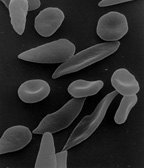Balancing selection facts for kids
Balancing selection refers to selective processes by which different alleles (different versions of a gene) are kept in the gene pool of a population at frequencies above that of gene mutation.
This usually happens when the heterozygote for a gene has a higher relative fitness than the homozygote. In this way genetic polymorphism is conserved.
Evidence for balancing selection can be found in the number of alleles in a population which are maintained above mutation rate frequencies. All modern research has shown that this significant genetic variation is common in panmictic populations. It is the field experience of Darwin, Wallace and others, that natural populations in the wild are extraordinarily varied. Museum collections of single species tell the same story.
There are several ways balancing selection works to maintain polymorphism. The two major and most studied are heterozygote advantage and frequency-dependent selection.
Contents
Mechanisms of balancing selection
Heterozygote advantage

In heterozygote advantage, or heterotic balancing selection, an individual who is heterozygous at a particular gene locus has a greater fitness than a homozygous individual. Polymorphisms maintained by this mechanism are balanced polymorphisms.
A well-studied case is that of sickle cell anemia in humans, a hereditary disease that damages red blood cells. Sickle cell anemia is caused by the inheritance of a variant hemoglobin gene (HgbS) from both parents. In these individuals, hemoglobin in red blood cells is extremely sensitive to oxygen deprivation, and this causes shorter life expectancy.
A person who inherits the sickle cell gene from one parent, and a normal hemoglobin gene (HgbA) from the other, has a normal life expectancy. The heterozygote is resistant to the malarial parasite which kills a large number of people each year. The heterozygote frequency is kept high because of the fierce selection against both the homozygotes.
The heterozygote has a permanent advantage (a higher fitness) wherever malaria exists.
Frequency-dependent selection
Frequency-dependent selection occurs when the fitness of a phenotype depends on its frequency.
In positive frequency-dependent selection the fitness of a phenotype increases as it becomes more common. In negative frequency-dependent selection the fitness of a phenotype increases as it becomes less common. For example, in prey switching, rare morphs of prey are fitter because predators concentrate on more frequent morphs.
Fitness varies in time and space
The fitness of a genotype may vary greatly between larval and adult stages, or between parts of a habitat range.
Selection acts at different levels
The fitness of a genotype may depend on the fitness of other genotypes in the population: this covers many natural situations where the best thing to do (from the point of view of survival and reproduction) depends on what other members of the population are doing at the time.
Images for kids
See also
 In Spanish: Selección disruptiva para niños
In Spanish: Selección disruptiva para niños





